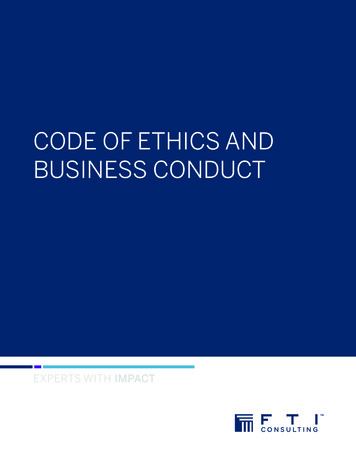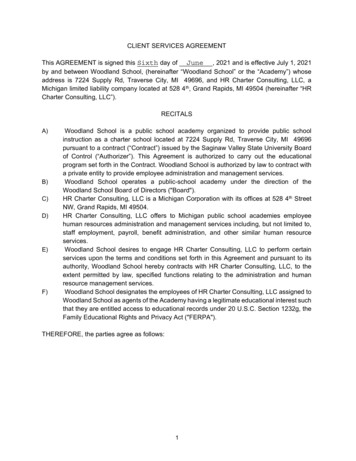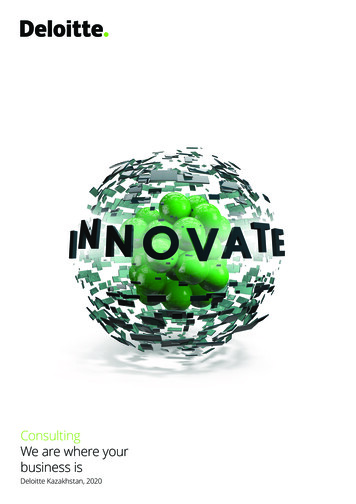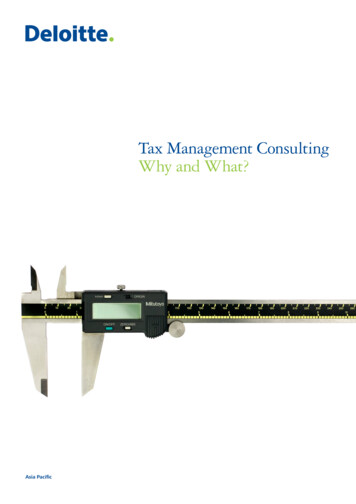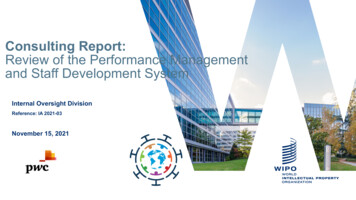
Transcription
Consulting Report:Review of the Performance Managementand Staff Development SystemInternal Oversight DivisionReference: IA 2021-03November 15, 2021
Table of ContentsHeadingsPage(s)List of Acronyms3Objectives, Scope and Methodology4Section 1 - Executive Summary and High Level Recommendations5-13Section 2 - Maturity Assessment Detailed Results14-23Section 3 - The Voice of WIPO Employees24-45Section 4 - Leading Performance Management research and practice46-52Recommendations and Action Plans53-55Annex - Current PMSDS process at WIPO56-69World Intellectual Property Organization - IA 2021-032
List of AcronymsAIMSAdministration Information Management SystemD&PDiversity and InclusionIODInternal Oversight DivisionITInformation TechnologyKPIKey Performance IndicatorL&DLearning and DevelopmentPIPPerformance Improvement PlanPMSDSPerformance Management and Staff DevelopmentSystemRRPRewards and Recognition ProgramUNUnited NationsWIPOWorld Intellectual Property OrganizationWorld Intellectual Property Organization - IA 2021-033
Objectives, Scope and MethodologyContextScope and MethodologyThe World Intellectual Property Organization (WIPO) has recently embarked on a review of the currentPerformance Management model. In that regard, the Internal Oversight Division (IOD) together with PwC,conducted a consultancy review and evaluation of the WIPO Performance Management approach andmade recommendations to support the change process.ObjectivesThe scope covered 2019 and 2020, and the methodology included: interviews with keystakeholders, interviews with representative groups/individual, document reviews, casestudies, benchmarking with best practices, and a culture thumbprint survey.Outputs The objectives of this review is to assess whether the Performance Management and Staff Development(PMSDS) Framework at WIPO is fit for purpose, aligned with the Organization’s new Medium TermStrategic Plan to achieve better business results, and empowers WIPO’s staff to perform at the highestlevel. The review focuses on verifying if the current approach and framework:1. Aligns teams and individual goals to the Organization’s top priorities; empowers teams to set aspirationalgoals and transparently track progress;2. Promotes the development of a highly engaged, capable workforce that proactively espouses innovationand change agility, and provides real time insights into employee performance;3. Reflects WIPO’s mission and values, promotes a culture of diversity and inclusiveness and differentiatesthe Organization from others; and4. Functions as a key driver of engagement and contributes to a positive meaningful work environmentcharacterized by trust and inclusivity.The review also assessed whether WIPO’s organizational culture promotes and rewards performance. It alsoassessed the maturity of performance management at WIPO. As a result of this exercise, it would bepossible to: Develop a baseline assessment on the state of Performance Management at WIPO;Generate data and insights to help make informed decisions about quick wins and longer-termstrategic developments; andUnderstand the predominant traits in the WIPO’s culture, including the strengths that can reliedupon, and challenges to mitigate.World Intellectual Property Organization - IA 2021-03 Each organizational process is evaluated to define its average maturity level;Outline of key strengths and possible areas for growth to inform further developments;Extracts of observations;Considerations on priority areas for change.Analysis of WIPO’s Performance Management maturity across seven pillars and30 design elements;How to read the Maturity Assessment reportThe report is based on data that was made available by WIPO and publiclyavailable information;The outcomes of the Performance Management Maturity Assessment should beviewed as a high-level Maturity Assessment, as opposed to a detailed andthorough evaluation of all Performance Management related activities,programmes and initiatives;The assessment provides an average picture of the maturity of the PerformanceManagement process across WIPO; any further detailed analysis in this respectwas carved out from the scope of this mandate;The “average suggested priority for change” outlines the level of priority WIPOcould apply to each pillar, either to reinforce strengths areas (quick wins) oraddress areas where there is an observed lack of maturity;As a next step and in conjunction with the effort to reshape the HumanResources (HR) strategy, WIPO should define its desired maturity for thedifferent dimensions of the Performance Management Maturity Model and build adetailed plan of action to tackle the selected focus areas.4
Section 1Executive Summaryand high levelrecommendations Key findings from the current stateKey findings for the future stateWhat we mean by “Maturity” in PerformanceManagementWIPO’s current Performance Management MaturityMaturity Assessment – key findings on a pagePrioritised recommendationsAlignment of WIPO’s culture with WIPO’s strategicaspirationsRecommendations on leading the required culturalchange5
Section 1 – Executive Summary ofthe review and high levelrecommendationsSection 2 – Maturity AssessmentDetailed ResultsSection 3 – The voice of WIPOemployeesSection 4 – Leading PerformanceManagement research and practiceAppendix – Current PMSDS processat WIPOKey findings from the current stateA traditional Performancemodel The current process at WIPO is based on traditional Performance Management principles and aligned tothe wider United Nations (UN) staff regulation;The current process includes an annual evaluationof performance based on yearly objectives, a midyear review and a final evaluation conducted by themanager;Employees can rebut evaluations stating anunderperformance if they do not agree with thisassessment or the comments made by themanager.Key observations from thecurrent model* Lack of trust in the performance process; Absence of a continuous feedback culture and fearof having difficult conversations; Heavy burden to manage administrative workload for managers, as the system is complex and notuser friendly;Perception of a “tick-box” exercise with little addedvalue for people;From an organizational standpoint, while PMSDS iseffective in ensuring alignment with task-relatedobjectives, it is not yet functioning as an integratedtool that encourages development and the growthmindset necessary for WIPO’s strategic ambitions;Lack of mobility means that certain staff may be“stuck” in a position where they cannot flourish;Managers lack the skills to effectively manageperformance; they are reluctant to tackleunderperformance and to sufficiently differentiatewhen assessing their team, which leads to aperformance rating inflation.Need for change*Employees have outlined their growingexpectations for change: They expect to see more objectivity, recognitionand development in the new model supported bya more user-centric and simple process; Managers expect more support from theOrganization to efficiently address theirchallenges in tackling underperformance; Employees have also raised the need for a deepcultural evolution of mindsets and behaviorsaround performance.*collected feedback from employees with different grades,genders, locations and functions across WIPO with the CulturalThumbprint survey, stakeholder interviews and focus groups.World Intellectual Property Organization - IA 2021-036
Section 1 – Executive Summary ofthe review and high levelrecommendationsSection 2 – Maturity AssessmentDetailed ResultsSection 3 – The voice of WIPOemployeesSection 4 – Leading PerformanceManagement research and practiceAppendix – Current PMSDS processat WIPOKey findings for the future stateWhat we see (and hear) in the market*What does this mean for WIPOThere is a lot of noise around what other organizations are doing regarding PerformanceManagement, which is one of the most widely despised business processes by people inorganizations across all industries:As there is no one-size-fit-all, there were specific challenges identified that a refreshedPerformance Management system would seek to address: Some are getting rid of the formal process. As experience shows, if the annualappraisal is removed, it must be replaced by another mechanism as it is stillnecessary to appraise employees and to reward them appropriately;Others embed a 360 review with stop/start/continue model that is more frequent(quarterly) with more real time “snapshot” assessments;Other organizations made changes to the annual appraisal process and revised therating process to make them more fair, transparent and forward looking.Learning from those cases is a great opportunity for WIPO to make sense from this“noise” and make decisions on a future model that is aligned both with its strategicambitions and cultural traits (see here for more details on the misalignment of WIPO’scurrent culture with strategic aspirations).*See here for selected case studies relevant to WIPO. A strategic shift towards more customer-centricity (see case study #1);A drive towards what neuroscience calls a “growth mindset”, fueled by a culture ofperformance and feedback (see case studies #2 and #3);The need for more agility and innovation, hindered by a lack of flexibility in thePerformance Management process (case study #3);A highly technically skilled workforce that generally lacks managerial skills andresistance to move away from traditional professional behaviors (case study #4).As WIPO is in the process of renewing its HR strategy as aligned to the most recentMedium-Term Strategic Plan, the working areas and areas for further improvement ofthe current model were identified, prioritized between quick wins and longer-terminitiatives here.In a nutshell, to make this change a success, it is crucial for the new model to be simple,more flexible to adapt to different realities and support communication and sharing offeedback. Middle management will be a key enabler to bring the new model to theirteams and day-to-day work. Enabling managers to do it right will be vital.Finally, engaging in a Cultural Change will require to focus on the Critical Few behaviorsthat can be leverage, to make changes to WIPO’s new Performance Model “stick”.World Intellectual Property Organization - IA 2021-037
Section 1 – Executive Summary ofthe review and high levelrecommendationsSection 2 – Maturity AssessmentDetailed ResultsSection 3 – The voice of WIPOemployeesSection 4 – Leading PerformanceManagement research and practiceAppendix – Current PMSDS processat WIPOWhat does Maturity in Performance Management mean?InitiatingPerformance Management Maturity LevelsLeadingWIPO is moving towards 2.0Initiating (maturity score : 1.0 - 2.9)Emerging (maturity score : 3.0 - 4.9)Leading (maturity score : 5.0 and above) Purpose: hold people accountable and Purpose: foster performance, good relationships,The highest maturity stage includes all the elements from the“emerging” stage and adds further value with additionaldifferentiating factors:provide documentation to defendagainst legal challenges upon contracttermination Goal setting: once a year only Evaluation: top-down, happens 2x ayeardevelopment, engagement and communication Goal setting: flexible and dynamic goals and priorities Evaluation: feedback is multidimensional, continuousand honest; performance discussions based on openfeedback culture and focused on evaluating impactand development Rating: rating-based system, forced Rating: potentially no formal rating or forced Process: heavy administrative burden Process: simple, streamlined with little administrativedistribution Recognition: no or limited reward andrecognition for high performance Integrated approach: PerformanceManagement is not integrated with otherpeople development functions (i.e.career progression, assignment orsuccession planning)distributionburden Recognition: formal and informal Integrated approach: performance is part of anintegrated approach incl. Learning and Development(L&D), Talent Management and Career Developmentand overall business strategy Strategy: strategically develop skills and talents that driveoverperforming business and organizational results vs. peersin the industry Technology: leverage cutting-edge technologies (i.e. VirtualReality, Artificial Intelligence, Big data) Growing Talents: performance is an essential part of talentdevelopment strategy to grow and develop a long term andsustainable internal talent and succession pipeline Employee Value Proposition: performance is integrated intothe employee value proposition where future employeesexpect to be high performing in exchange for fast individualdevelopment, career progression and high employability.World Intellectual Property Organization - IA 2021-038
Section 1 – Executive Summary ofthe review and high levelrecommendationsSection 2 – Maturity AssessmentDetailed ResultsSection 3 – The voice of WIPOemployeesSection 4 – Leading PerformanceManagement research and practiceAppendix – Current PMSDS processat WIPOWIPO’s current Performance Management MaturityPerformance Management pillars.diverse sources used for maturityanalysis.Documentation reviewPurpose and Strategy60 documentsreviewedCulture and CommunicationPeople Management101-2-1 stakeholderinterviewsCareer and DevelopmentEmergingLeadingData gatheredacross 30 design elements3 workingsessions with IODand HRMDfocus groupsacross multipledepartments Feedback is transparent Training available oncommunication skills Specific managerialcapabilities evaluated Mentoring program pilotFocus Groups2Reward and RecognitionInitiatingInterviews & Working SessionsPerformance ProcessIT System. to derive WIPO’s current PerformanceManagement Maturity25participantsacross WIPO Detailed andhomogeneous process Current IT system is aSaaS modelCultural Thumbprintsurvey resultsFrom500 people across WIPO Low staff turnover High-level of loyaltytowards seniormanagementAverage Performance Management Maturity1.8 – InitiatingWorld Intellectual Property Organization - IA 2021-03Source: PwC analysis9
Section 1 – Executive Summary ofthe review and high levelrecommendationsSection 2 – Maturity AssessmentDetailed ResultsSection 3 – The voice of WIPOemployeesSection 4 – Leading PerformanceManagement research and practiceAppendix – Current PMSDS processat WIPOMaturity Assessment – key findings on a pageMaturity score scaleMaturitypillarsPurposeStrategy andStrategyEstimatedMaturitylevelCulture andOperatingCommunicationModeland KPIs2.0Initiating PerformanceManagement objectivescan be aligned withProgram Activities(optional)What'sworking1.3Initiating Areas acticesCurrent feedback istransparent in theInformation Technologies(IT) system (i.e. noanonymous feedback)Training material exist oneffective communication1.8Initiating Possibility to updateperformance objective atmid-year review Homogeneousperformance process Process can becompleted quickly Mentoring program pilot Flexible goal setting basedon shorter-term priorities Invest on upskillingmanagers on: feedback,coaching, inclusiveleadership, goals andexpectations setting withtheir teams (both keyperformance indicators(KPIs) and behaviors)Improve consequencemanagement for bothhigh/under performers Actively engage a culturaltransformation to fostermore honest communication Define clear purpose ofperformance model (i.e.developmental vs.compliance) Consistently traincommunication skills (i.e.using regular nudging) Introduce 360 feedbackincl. anonymous upwardsfeedback to grasp fullpicture from multiplesources Separate feedback fromperformance ratingFormalize the roles ofcareer coach and mentor Make managersaccountable for staffengagement survey results Create and communicateexpectations for managerswith best practice guidelines(e.g. on regular check-ins,proactively managingperformance)Rebrand PMSDS withrevised purpose Communicate messagingthat “everyone has toimprove” Enable HRMD to play amore strategic role Work with businesssponsor to redesignperformance model anddrive business ownership Consistently alignindividual objectives withProgram Activities (topdown)World Intellectual Property Organization - IA 2021-03 Explore mechanisms formore informal and frequentfeedback to be built intoWIPO people’s routine Include Diversity, Equityand Inclusion perspectivesin performance policies Introduce an informalrecognition platformInitiating : 1.0 - 2.9Clear and detailedprocess with sufficientsupporting documentsReward andCommunicationIT ing Current PerformanceManagement is based onthe PeopleSoft HCM,Oracle technology Current IT system is aSaaS modelIntroduce calibration inmoderation meetings toensure fair distribution ofperformance rating acrossdivisions Replace existing IT systemwith a more modern, userfriendly, mobile and cloudbased solution with regularupdates Determine PMSDS purposeaccountability/development Generate consistent,accurate & actionable data Simplify and de-formalisethe process for moreconversation and lessdocumentation Analyze performance datato identify indicators thatrequire HR interventions tosustain performance Improve the triage of appealcases by building clearcriteria for accessing theprocess Identify relevanttechnologies to automaterepetitive and admin taskssuch as Nudging or NaturalLanguage Processing Introduce a differentiatedrating scale allowing morenuanced evaluation Explore informal feedbackmechanisms Set collective goals toencourage collaborationEmerging : 3.0 - 4.9ITCommunicationIT SystemandSystemCulture3.0EmergingManagers have specificmanagerial capabilitiesthat are evaluated PerformanceProcess: “Bold moves” Existing Reward andRecognition Programwith four types of awards Consider rewarding staff inother ways: informal,autonomy, purpose, newrelationships Involve managers innominating and presentingawards to their teams Increase volume ofcollective and crossdivisional rewards to fostercollaboration andemphasize teamperformance Develop a business case forMember States to approvehigher impact Reward andRecognition ProgramLeading : 5.0 - aboveCareer andDevelopment1.6Initiating Low staff turnover High-level of loyaltytowards seniormanagement Use performance output toinform succession planningand career development Reframe mobilityopportunities as reward andencourage performance anddevelopment Integrate performance withother key people processesincl. L&D, TalentManagement and CareerDevelopment Revisit the performanceimprovement plan (PIP)process to includedevelopment element Revaluate careerprogression and promotioncriteria10
Section 1 – Executive Summary ofthe review and high levelrecommendationsSection 2 – Maturity AssessmentDetailed ResultsSection 3 – The voice of WIPOemployeesSection 4 – Leading PerformanceManagement research and practiceAppendix – Current PMSDS processat WIPOAlignment of WIPO’s culture with its strategic aspirationsStrategy House from Medium-term strategic plan 20222026Results from Culture ThumbprintInnovationEnablingculture traitsresultsSelf reportedresultsLow Medium HighLow Medium HighYou can find the detailed results onculture traits enabling innovation in theWIPO Culture Thumbprint Report .DigitalizationEnablingculture traitsresultsSelf reportedresultsCustomer/Client -CentricityEnablingculture traitsresultsSelf reportedresultsLow Medium HighLow Medium HighYou can find the detailed results on culturetraits enabling agility (anticipating andresponding to disruption), high quality(quality), and customer centricity in theWIPO Culture Thumbprint Report.CollaborationLow Medium HighEnablingculture traitsresultsLow Medium HighLow Medium HighSelf reportedresultsLow Medium HighYou can find the detailed results onculture traits enabling digitalization in theWIPO Culture Thumbprint Report.You can find the detailed results on culturetraits enabling collaboration in the WIPOCulture Thumbprint Report.World Intellectual Property Organization - IA 2021-0311
Section 1 – Executive Summary ofthe review and high levelrecommendationsSection 2 – Maturity AssessmentDetailed ResultsSection 3 – The voice of WIPOemployeesSection 4 – Leading PerformanceManagement research and practiceAppendix – Current PMSDS processat WIPORecommendations on leading the required cultural changeImplementing the revised Performance Management model will require WIPO to gothrough a cultural transformation to overcome the barriers to changeFocus on the‘critical few’Focus on the ‘criticalfew’ behaviours that ifaddressed, wouldfundamentally realignhow WIPO’sworkforce act towardseach other every day.(e.g. innovation,quality, collaboration)Start at the topWIPO’s workforce looks at how you are at work everyday. Soinstead of talking about the change, taking action will be critical,especially in WIPO’s leadership.Identify and empower informal leadersGetting WIPO’s workforce involved in designing and driving thechange will garner support across all levels of the Organisation fromDay 1 – WIPO should identify its informal leaders and mobilize themto build support from within.Empower & encourage innovation at the grassrootsWorkforce behavior change is a true sign that a cultural evolution istaking hold. In parallel to management taking the lead, it is also theWIPO staff that need to make change stick.World Intellectual Property Organization - IA 2021-0312
Section 1 – Executive Summary ofthe review and high levelrecommendationsSection 2 – Maturity AssessmentDetailed ResultsSection 3 – The voice of WIPOemployeesSection 4 – Leading PerformanceManagement research and practiceAppendix – Current PMSDS processat WIPOPrioritised recommendationsBelow are some considerations for further strategic development and actionsShort term quick winsPurpose and Strategy Define clear purpose ofperformance model (i.e.developmental vs. compliance) Work with business sponsor toredesign performance modeland drive business ownership Improve consequencemanagement for bothhigh/under performersCulture and Communication Introduce 360 feedback incl.Strategic long-term actionsPerformance Process Introduce moderation meetingsto ensure fair distribution ofperformance rating acrossdivisions to improve staff’s trustin the process Simplify and deformalize theprocess for more conversationand less documentation Introduce a differentiated ratingscale allowing more nuancedevaluation Set collective goals (i.e. at teamor across team levels) topositively influencecollaboration cultureReward and Recognition Consider rewarding staff inother ways: informal, autonomy,purpose, new relationships Increase volume of collectiveand cross-divisional rewards tofoster collaborationCulture and Communication Actively engage a culturaltransformation aligned withWIPO’s strategic ambitions(collaboration and innovation),by leveraging the Critical Fewbehaviours.People ManagementCareer and Development Revisit the PIP process toinclude development element Invest on upskilling managerson: feedback, coaching,inclusive leadership, goals andexpectations setting with theirteams (both KPIs andbehaviors)anonymous upwards feedbackto grasp full picture frommultiple sources Explore mechanisms for moreinformal and frequent feedbackto be built into people’s routineIT System Replace existing IT system witha more modern, user-friendly,mobile and cloud-basedsolution with regular updatesReward and Recognition Develop a business case forMember States to approvehigher impact Reward andRecognition ProgramCareer and Development Reframe mobility opportunitiesas reward and encourageperformance and developmentRebrand PMSDS with revised purpose & mobilise a change management workstreamWorld Intellectual Property Organization - IA 2021-0313
Section 2Maturity AssessmentDetailed Results The seven pillars of Performance Management inscope for this reviewThe detailed frameworkDetailed results per Performance Management maturitypillar14
Section 1 – Executive Summary ofthe review and high levelrecommendationsSection 2 – Maturity AssessmentDetailed ResultsSection 3 – The voice of WIPOemployeesSection 4 – Leading PerformanceManagement research and practiceAppendix – Current PMSDS processat WIPOThe 7 pillars of Performance Management in scope for thisreviewDescriptionPurpose andStrategy Role of Performance Management in WIPO’s strategic agenda Indications of how organizational mandate is translated into individual or collective objectives Role played by HR in the development and application of performance appraisalCulture andCommunication Cultural landscape surrounding the performance appraisal with influence over its role and perception Extent to which cultural norms, behaviors and values influence how appraisal processes are conducted Language and terminology used in processes and policies to refer to performance appraisalPeopleManagement Maturity of people management practices in the organization, in particular at mid-management levels Frequency of performance discussion between staff and their manager(s)PerformanceProcess Structure of performance appraisal processes, roles and responsibilities Design of performance appraisal tools and systems and administrative recording Level of homogeneity in the evaluation across different staff groupsIT System Accuracy, reliability and availability of performance data to drive HR strategic decision making Accessibility and simplicity of technology supporting performance appraisal End-user experience of performance appraisal processes, tools and systemsReward andRecognition Policies regulating the application of performance appraisal Policies regulating the reward and recognition of performance appraisal Level of impact of performance appraisal over fixed and variable compensationCareer andDevelopment Degree of integration of performance appraisal with other people and career development processes Elements of performance appraisal used to inform career progression, internal roles mobility and succession planningWorld Intellectual Property Organization - IA 2021-0315
Section 1 – Executive Summary ofthe review and high levelrecommendationsSection 2 – Maturity AssessmentDetailed ResultsSection 3 – The voice of WIPOemployeesSection 4 – Leading PerformanceManagement research and practiceAppendix – Current PMSDS processat WIPOThe detailed eModelandand entPerformanceProcessCommunicationITIT SystemandSystemCultureCommunicationReward andIT SystemandCultureRecognitionCareer andDevelopmentPurposeCultureEvaluation r progressionRole of HRTransparencyMeasurementProcess achStrategicalignmentMultidimensionalfeedbackGoal ionRotationand AssignmentRole of ManagerFeedbackfrequencyManagement unicationnarrativeProcessdifferentiationDiversity ntLearning &DevelopmentWorld Intellectual Property Organization - IA 2021-0316
Section 1 – Executive Summary ofthe review and high levelrecommendationsSection 2 – Maturity AssessmentDetailed ResultsSection 3 – The voice of WIPOemployeesSection 4 – Leading PerformanceManagement research and practiceAppendix – Current PMSDS processat WIPOPurpose & StrategyAverage maturityscore2.0InitiatingAverage suggestedpriority for change*MediumSome observationsPurpose ofPerformanceManagement Current PMSDS is pursuing multiple objectives at the same time (evaluating performance,identifying training needs, addressing behaviours and disciplinary actions). There is a general perception that PMSDS is used to document issues for punitivepurposes. PMSDS guidelines and policies are substantially process driven. Not clear in policies where is the limit between Performance Management consequences(i.e. tackling underperformance) and disciplinary actions consequences.Role of HR HR role is mainly administrative to coordinate process, resolve issues and disagreements. Current performance model does not enable HR to play a strategic role due to the lack ofstrategic focus of this process, makes it difficult to drive value for the organization. Managers are encouraged by the organization to address underperformance but do notfeel backed up when they have to deal with the aftermath (i.e. conflicts, fear of appeal).Strategicalignment Performance objectives can be linked to Program Activities however this is notconsistently observed across the Organization. The level of performance in the Organization is not consistent, some staff members arehighly performing, compensating for others which are not addressed through PMSDS.Role ofSupervisor There is a people management capability framework which outlines expected peoplemanagement skills and behaviors. Technical skills are more important than managing skills to appoint new managers. Some managers have very large people management span, with sometimes more than 10direct reports, which doesn't enable good management practices.World Intellectual Property Organization - IA 2021-03*here you see the average of the priority ratings for theindividual elements of this dimension (diagram on the right)lowhigh17
Section 1 – Executive Summary ofthe review and high levelrecommendationsSection 2 – Maturity AssessmentDetailed ResultsSection 3 – The voice of WIPOemployeesSection 4 – Leading PerformanceManagement research and practiceAppendix – Current PMSDS processat WIPOCulture & CommunicationAverage maturityscore1.3InitiatingAverage suggestedpriority for change*HighSome observationsCulture Perception that relationships with leaders matter more than performance for careeradvancement (i.e. not meritocratic). Wh
The outcomes of the Performance Management Maturity Assessment should be viewed as a high-level Maturity Assessment, as opposed to a detailed and thorough evaluation of all Performance Management related activities, programmes andinitiatives; The assessment provides an average picture of the maturity of the Performance




